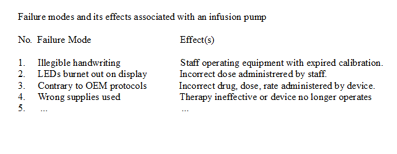
HFEMA infusion pump example
About[]
Health care Failure Mode & Effect Analysis (HFMEA) - A prospective assessment that identifies and improves steps in a process thereby reasonably ensuring a safe and clinically desirable outcome. A systematic approach to identify and prevent product and process problems before they occur. [1]
Basic terms[]
Failure mode: "The manner by which a failure is observed; it generally describes the way the failure occurs."
Failure effect: Immediate consequences of a failure on operation, function or functionality, or status of some item.
Indenture levels: An identifier for item complexity. Complexity increases as levels are closer to one.
Local effect: The Failure effect as it applies to the item under analysis.
Next higher level effect: The Failure effect as it applies at the next higher indenture level.
End effect: The failure effect at the highest indenture level or total system.
Failure cause: Defects in design, process, quality, or part application, which are the underlying cause of the failure or which initiate a process which leads to failure.
Severity: "The consequences of a failure mode. Severity considers the worst potential consequence of a failure, determined by the degree of injury, property damage, or system damage that could ultimately occur."
Uses of FMEA[]
- Development of system requirements that minimize the likelihood of failures.
- Development of methods to design and test systems to ensure that the failures have been eliminated.
- Evaluation of the requirements of the customer to ensure that those do not give rise to potential failures.
- Identification of certain design characteristics that contribute to failures, and minimize or eliminate those effects.
- Tracking and managing potential risks in the design. This helps avoid the same failures in future projects.
- Ensuring that any failure that could occur will not injure the customer or seriously impact a system.
- To produce world class quality products
Advantages[]
These are some examples of its benefits:
- Improve the quality, reliability and safety of a product/process
- Improve company image and competitiveness
- Increase user satisfaction
- Reduce system development timing and cost
- Collect information to reduce future failures, capture engineering knowledge
- Reduce the potential for warranty concerns
- Early identification and elimination of potential failure modes
- Emphasize problem prevention
- Minimize late changes and associated cost
- Catalyst for teamwork and idea exchange between functions
- Reduce the possibility of same kind of failure in future
Types of FMEA[]
- Process: analysis of manufacturing and assembly processes
- Design: analysis of products prior to production
- Concept: analysis of systems or subsystems in the early design concept stages
- Equipment: analysis of machinery and equipment design before purchase
- Service: analysis of service industry processes before they are released to impact the customer
- System: analysis of the global system functions
- Software: analysis of the software functions
References[]
- ↑ VA National Center. Safety Topics. access-date 2013. http://www.patientsafety.gov/SafetyTopics.html